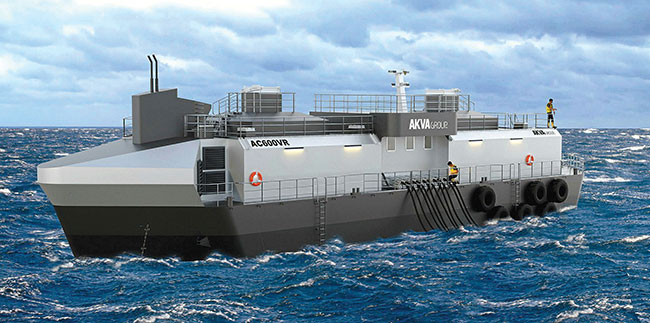
New type of feeding technology makes breakthrough
December 7, 2020
By
Liza Mayer
 AC 600 VR feed barge is equipped with a waterborne feeding system, which is said to offer better environmental and cost benefits
Photo: AKVA Group
AC 600 VR feed barge is equipped with a waterborne feeding system, which is said to offer better environmental and cost benefits
Photo: AKVA Group A waterborne feeding technology first introduced at the Aqua Nor exhibition last year is beginning to find commercial applications as the technology matures.
Waterborne feeding, where the feeding system uses water instead of air to transport pellets into salmon pens, offers better environmental and cost benefits compared to the traditional airborne feeding, says developer AKVA Group.
The Norwegian technology firm installed the waterborne feeding system into an AC 600 VR feed barge acquired by salmon producer SinkabergHansen. The salmon farmer initially leased the barge from AKVA in Autumn 2019 to try out the new technology. It proceeded to acquire it in October 2020.
“The largest bottleneck for introducing this new environmentally friendly and cost-saving technology in the market is to show that the waterborne feeding system is stable in operation and provides at least the same growth rate as airborne feeding. In this context, this feed barge sale to SinkabergHansen, and the collaboration with them, is very important for further market development,” says Hans-Øyvind Sagen of AKVA Group Nordic. He sees opportunities for existing barges to adopt the waterborne feeding technology.
One of the major benefits cited is the reduced energy requirement of waterborne feeding by 70 to 90 percent compared to traditional airborne feeding. By replacing air with water, the system is significantly gentler on both the feed and the feeding pipe, thus reducing feed breakage, noise and microplastic discharge, said the developer. Pellet density is also not an issue, and the capacity is said to be more than double compared to the traditional air feeding system.
“The environmental and cost benefits of waterborne feeding are so great that we see it as justifiable to invest in this type of feeding technology,” said Svein-Gustav Sinkaberg, CEO of the salmon producer.





